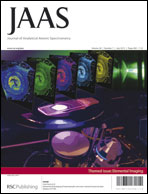A novel approach for post-digestion stabilisation of osmium was developed and evaluated as a proof of concept during this study. Regulatory requirements for the testing of Os contents in pharmaceutical products are now included in the new general USP chapters 〈232〉 and 〈233〉, as well as in EP chapters 5.20 and 2.4.20. A new ICH guideline for elemental impurities Q3D is in preparation. Therefore, trace elemental analysis of Os will be required for release testing of pharmaceutical substances and final products in the near future. In this study Os determination was performed by inductively coupled plasma mass spectrometry (ICP-MS) after nitric acid pressure vessel digestion. Since osmium in an oxidising and acidic environment readily forms volatile species, there is a need for osmium stabilization to prevent the loss of these fractions or to prevent overestimation due to vapour enrichment in spray chambers used on ICP instruments. Pressure vessel digestion with nitric acid is a universal mineralisation method for organic compounds in order to determine trace elemental concentrations and will be required to meet the new pharmacopeial regulations. Therefore, it is in principle possible to cover the whole list of required elements in USP 〈232〉 to be tested in one digestion run, now including osmium, since an aliquot of the digestion solution is stabilised using the presented stabilisation solution whereas the rest of the digestion solution can be used for the determination of the other required trace element contents. In this study we demonstrated the suitability of thiourea as a complexing agent for osmium. Already millimolar quantities of thiourea in combination with ascorbic acid in acidic media allowed the stabilization of μg L−1 quantities of osmium in solution following high-pressure digestion. To meet method validation requirements, a spike recovery experiment with real world samples, the pharmaceutical excipient Avicel, was performed to evaluate this type of stabilization in combination with high-pressure digestion with concentrated nitric acid. First proof of concept experiments showed average recoveries of 81% for samples spiked with 1.0 μg g−1 osmium and a precision of 7% for six-fold preparation and measurement. Additional experiments showed that matrix-matched calibrations may be mandatory for reliable determination of osmium contents.

You have access to this article
 Please wait while we load your content...
Something went wrong. Try again?
Please wait while we load your content...
Something went wrong. Try again?


 Please wait while we load your content...
Please wait while we load your content...